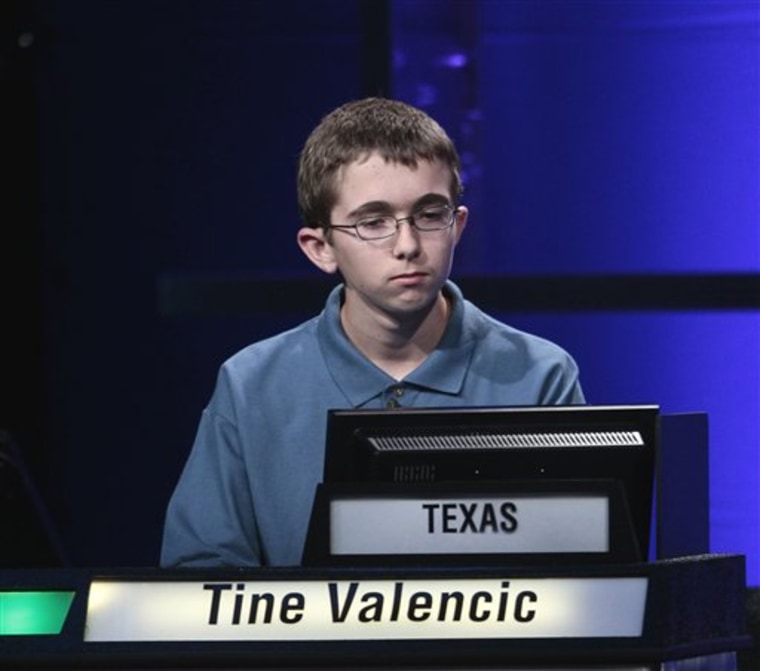A 13-year-old boy from Texas won the National Geographic Bee on Wednesday by correctly identifying the country that is home to the Tungurahua volcano.
Tine Valencic of Colleyville didn't miss a single question during the final round of the geography bee, defeating nine other boys and taking home a $25,000 scholarship and a trip to the Galapagos Islands. The answer that made the difference: Ecuador.
"I'm just taking it all in," he said after winning and being lent tissues to dry his eyes by both the bee moderator, "Jeopardy!" host Alex Trebek, and the bee's second-place finisher.
To get to the 23rd annual bee in Washington, students had to be in the fourth through eighth grades and had to win their respective state-level competitions. The group competed in a preliminary round Tuesday, which narrowed the field to 10.
In the final round Wednesday at the National Geographic's headquarters, students answered questions ranging from identifying countries' flags to naming the country that calls the "bandura" its national instrument: Ukraine.
Primatologist Jane Goodall and Secretary of State Hillary Clinton both asked taped video questions, and at one point a frog was brought onstage and students, given the hint that it lived in the Entre Rios province, had to correctly name Argentina as its home. Another round of questions featured Google Earth views of various locations.
To clinch the victory, Tine won a best-of-five final round against 11-year-old Nilai Sarda of Georgia.
Writing the answers on sheets of paper, both boys answered the first three questions correctly, including giving the Italian name for sediment deposits that connect a shoreline with an offshore island: "tombolo."
But Nilai, a cricket and chess player from Atlanta, stumbled on the fourth question about the Tungurahua volcano, believing incorrectly that it was in Peru.
The final question in the round asked for the name of the Nepalese national park where the southern part of Mount Everest is located: Sagarmatha National Park. Both boys got that right, sealing Tine's win. Nilai takes home $15,000 for second place. Third-place finisher Stefan Petrovic of Lawrence, Kan., won $10,000.
Getting to this year's bee was no small feat for Tine. At the finals in Texas, officials ran out of questions to ask because the finalists were doing so well and had to go to an emergency packet of questions.
The seventh grader from Colleyville Middle School eventually emerged victorious, however.
This year was the second time that Tine won the state championship and got to the national bee, though he did not reach the finals of the national bee last year. In both years he had to beat his twin brother at the school level of the competition.
This year, Tine studied by reviewing a 24-page spreadsheet filled with facts ranging from ethnic groups and rivers to physical features. Quizzing him on each page took an hour, said his mom Jana Valencic, adding that they limited his study time on the weekend or he would have done more.
On Wednesday some of his correct answers included naming the capital city southeast of Angkor Wat, Phnom Penh, and the name of the city that is home to the archdiocese of the Lutheran Church of Sweden, Uppsala.
Aside from the three top-place finishers, the finalists competing Wednesday were: Alex Kimn of South Dakota, Kevin Mi of Indiana, Luke Hellum of Arizona, Tuvya Bergson-Michelson of California, Karthik Karnik of Massachusetts, Anthony Cheng of Utah and Andrew Hull of Alaska.
The bee, which was sponsored for the third year by Google, will be broadcast on National Geographic Channel over four nights in June and will also be broadcast on public TV stations. Of the 54 participants from every state, the District of Columbia, defense Department schools and U.S. territories, just five were girls.
